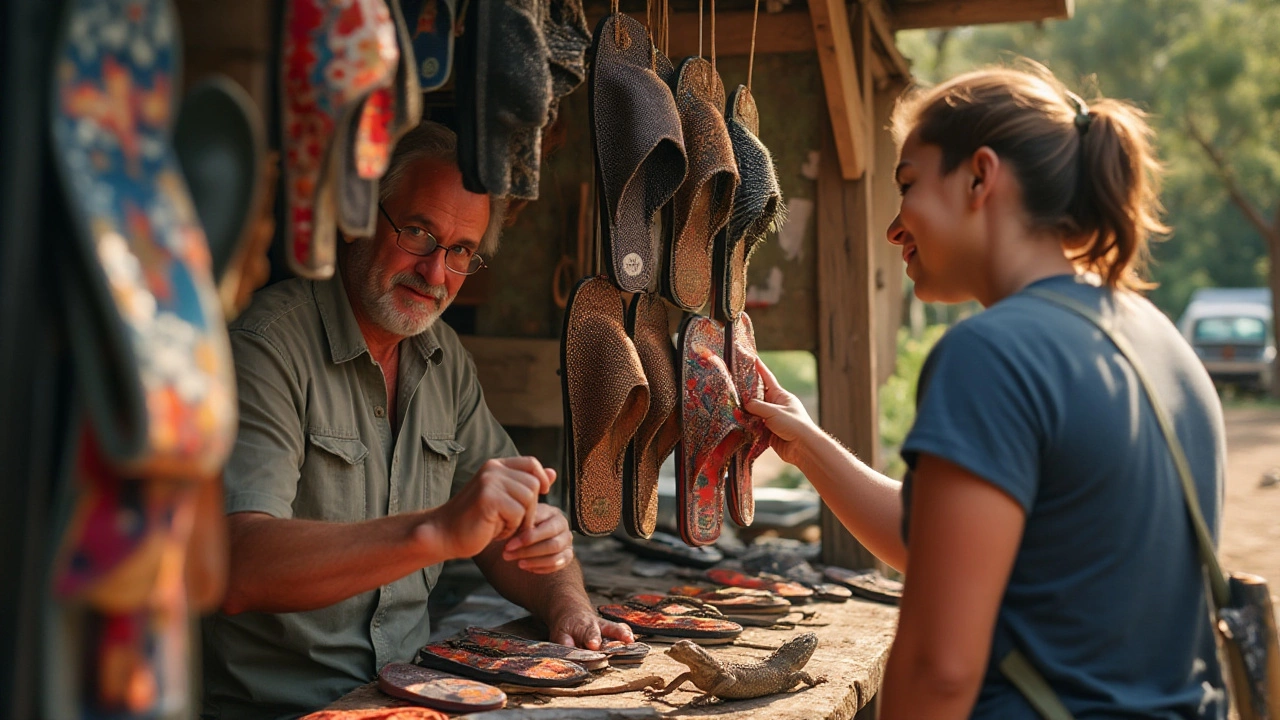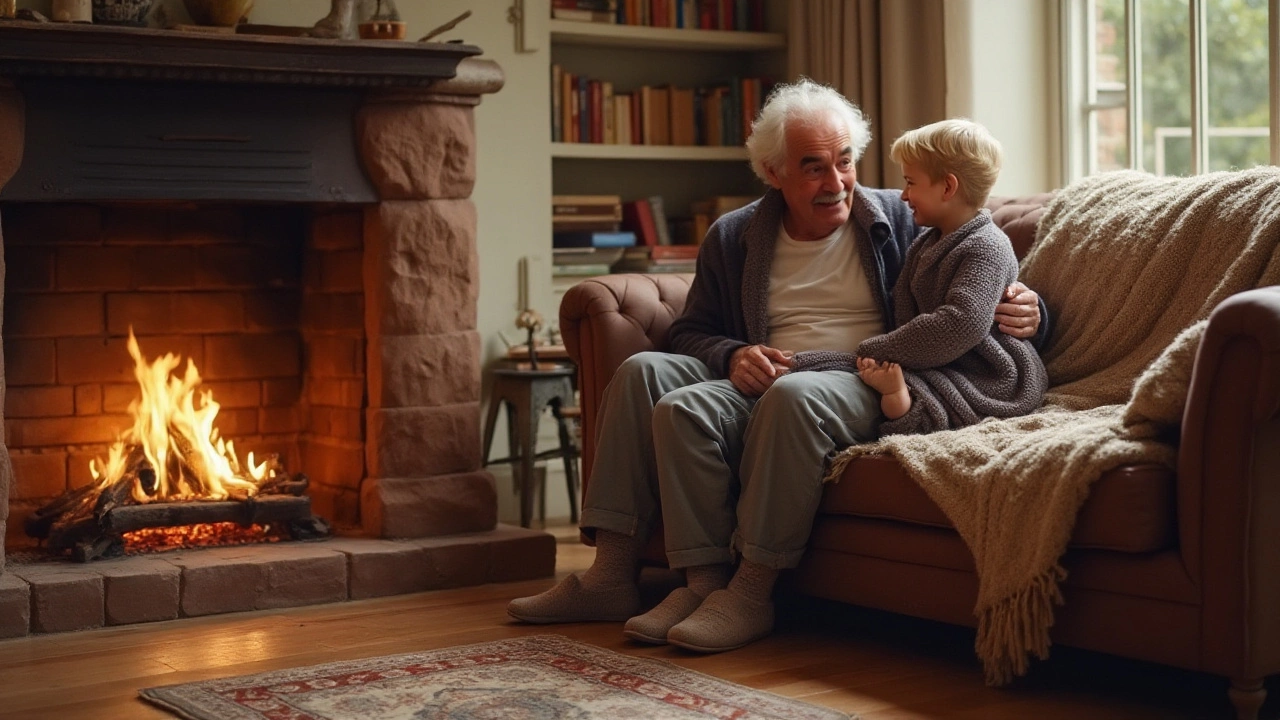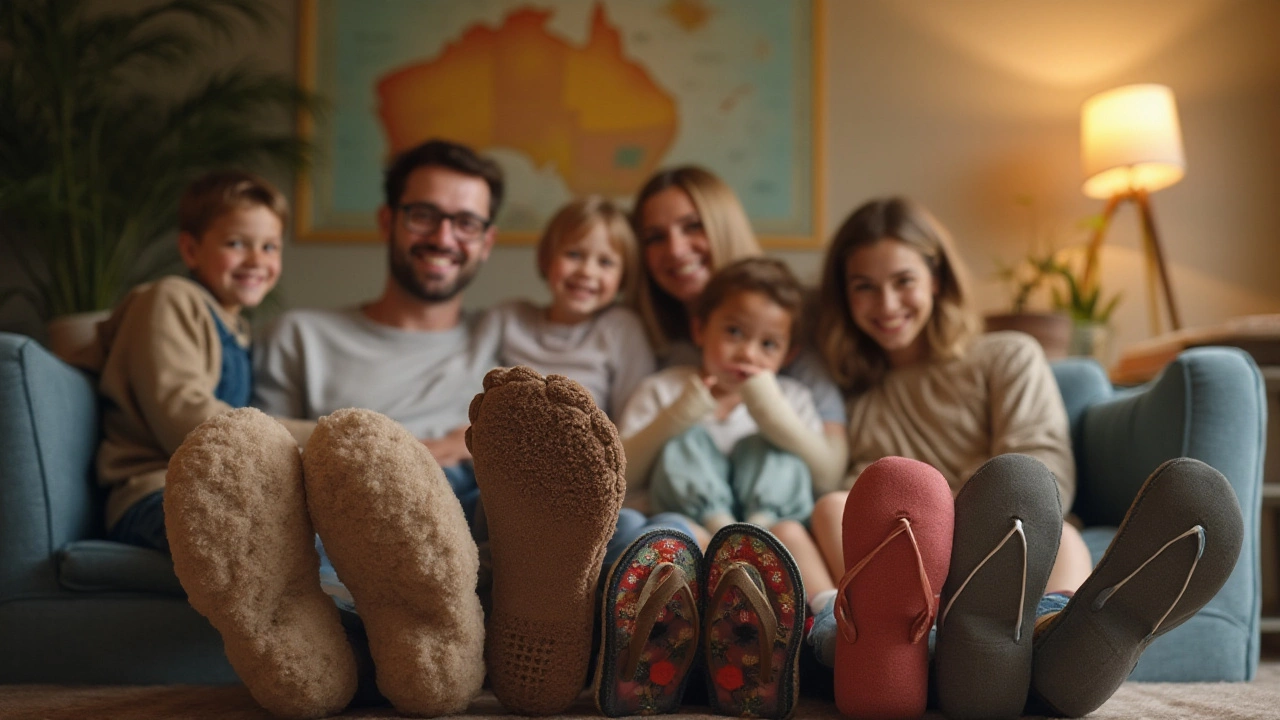When it comes to the cozy comfort of home footwear, Australians have their own unique take. In the land Down Under, slippers aren't just called slippers—they often go by charming alternative names that evoke a sense of regional pride and cultural flavor.
In this article, we're embarking on a linguistic journey to uncover what Australians call their beloved indoor footwear, exploring the terms that vary as much as the country's vibrant landscapes. Whether it's a morning spent sipping a flat white or an evening wrapped in a soothing eucalyptus-infused aroma, knowing the local slang for slippers might just enrich your travels—or your understanding of Australian culture.
- The Aussie Lingo for Slippers
- Regional Variations and Nicknames
- Cultural Influences on Slipper Names
- Historical Origins of Slipper Terminology
- Practical Reasons Behind the Names
- Tips for Choosing Slippers in Australia
The Aussie Lingo for Slippers
Australia, a land celebrated for its distinctive wildlife and picturesque coastlines, also boasts a rich tapestry of words and phrases that reflect its vibrant culture. One of the delightful quirks of this vast land is the way Australians refer to their cozy indoor footwear. While the term 'slippers' is universally understood, in Australia, such footwear often goes by an equally charming term: 'ugg boots.' Australian slippers find themselves rooted in this colloquialism, thanks to the nation’s adoration of sheepskin comfort.
But there's more to it than that. Australians are fond of their idiomatic expressions, and their language surrounding footwear is no exception. When describing a pair of comfortable slippers, the more classic term like 'house shoes' might be replaced by something much friendlier and inviting. Depending on the region, you might hear them referred to as 'uggies' or simply 'uggs'—a term so well-integrated that it transcended borders to become a global brand, whether it’s a chilly winter's eve or a quick trek out to the mailbox. In chilly regions, 'ugg boots' play a crucial role in keeping the Aussie toes toasty during mild winters and cold evenings.
It's interesting to note that Aussie slang is not just about shortening words; it often involves creativity that paints an image or emits warmth. This same affection spills into how locals concisely label their shoes designed for snugness at home. Words can take on new life as playful monikers that feel closer to a friendly gesture rather than mere nomenclature. This cultural richness is something one shouldn't miss out on, whether visiting or studying Australian linguistics.
Additionally, another term that might catch your ear is 'thongs.' In Australia, 'thongs' famously refers to what others might call flip-flops or sandals, but this cultural intersection demonstrates how language evolves with usage contexts. Though not directly relating to Australian slippers, it illustrates the Aussie penchant for unique naming. According to the Australian National Dictionary Centre, the creative use of English in Australian society adds a flair of humor that can enliven common terms and make one’s speech trailblaze its comforting paths, just like the cozy slippers in question.
So, whether you're slipping into your nightly routine or padding around on a lazy Sunday morning, the terms the Australians use for their slippers resonate with a sense of endearment and relaxation that perfectly mirrors their purpose. For the non-Australian, picking up these phrases might just enrich one’s experience and connection to the footloose and culturally rich lifestyle.
"Ugg boots have a cultural significance that goes beyond their function," noted the Australian Geographic. "They are a symbol of the laid-back and practical mindset that pervades the Australian lifestyle."
As one navigates the myriad words Australians use for slippers, one finds an enriching opportunity to appreciate the nation’s linguistics just as much as its landscapes. The next time you encounter someone slipping into their 'uggs' or 'uggies,' you will have unlocked a small but meaningful part of Australia’s daily vernacular—an open invitation to warmth, humor, and linguistic enjoyment.
Regional Variations and Nicknames
Australia is a vast continent, and much like its landscapes, the language and cultural nuances shift from region to region. Here, the humble slipper takes on various names, with influences deeply rooted in both tradition and local dialects. One common term you might hear in parts of Australia is the 'ugg boot', although more typically referring to a type of sheepskin boot, some locals might casually refer to their warm indoor footwear by the same name, particularly in chillier regions. Meanwhile, in different pockets of the country, slippers are simply known as 'house shoes'.
The influence of European settlers on Aussie vernacular can't be overlooked, with some older generations still using terms like 'brogues' or even 'dossies'—a nod to Irish and Scottish influences respectively. Much like a patchwork quilt, these names have been stitched together through Australia's rich multicultural tapestry. As you venture into rural areas, you'll find residents using names that might surprise you, perhaps even adapting international terms to fit the Aussie spirit. For instance, you might stumble across the humorous and endearing 'foot cuddies', a name that playfully describes the ultimate goal of any slipper.
Not only are the regional slang variations fascinating, but they also offer valuable insights into the history and social fabric of Australia.
John Doyle, an Australian historian, once noted, "Language is the window to the culture and lifestyle of a people. The way Aussies talk about something as mundane as slippers reveals their valuing of comfort and community."These unique slipper monikers reflect a society that finds joy in life's simple pleasures, using language to add warmth and humor to the mundane. Such regional nicknames are not just words but an echo of the land and its story.
Moreover, if you're exploring the vibrant cities like Sydney or Melbourne, the terminology might swing towards more contemporary takes, perhaps influenced by international fashions or trends. It's interesting to see how urban youth have been known to blend English with globetrotting influences, with some even calling their slippers 'slides' or 'house wraparounds', merging practicality with style. A traveler immersing themselves in Australian life will find these variations a charming way to embrace the local lexicon, offering a small but meaningful connection to the everyday lives of Aussies nationwide.

Cultural Influences on Slipper Names
In Australia, names for slippers are as diverse as its cultural mosaic. This fascinating blend of traditions, linguistic heritage, and regional quirks comes together to shape a rich tapestry of terms. From the bustling cityscapes to the tranquil outback, each area has its own localized word for the beloved home comfort that is the slipper. The influence of British colonization, along with the country's proximity to Asia and the migration from other parts of the world, have all contributed to this phenomenon. Consequently, Australians might refer to their slippers as 'ush-shees'—a playful twist on the word 'shoeshine'—or simply 'slip-ons,' borrowing from the straightforward naming conventions prevalent among British ancestors.
While many Australians embrace these traditional terms, there's an emerging trend to adopt global influences, often tailored to fit the uniquely Australian lifestyle. This merging of cultures is palpable in regions like Melbourne and Sydney, where eclecticism is celebrated. Australia’s multicultural cities, with their blend of languages, cuisines, and traditions, are key arenas where new terms and names are constantly being coined. Every year, Australian society increasingly reflects the vibrancy of its immigrant communities, creating an ever-evolving vocabulary surrounding daily items, slippers included. It's a testament to the nation's openness and adaptability.
The melting pot of cultures within Australia's borders is exemplified by the rise of terms influenced by indigenous languages, marking a respect for Aboriginal cultures. Some regions have started to incorporate indigenous words into everyday vernacular, emphasizing a commitment to honoring this ancient heritage. This not only enriches the slang but also strengthens cultural bonds. A visitor might hear a local refer to these cozy shoes by a word linked to the native flora or fauna—a unique marker of identity and pride.
According to the Australian Bureau of Statistics, "...one in four Australians were born overseas, highlighting the diverse cultural influences present in Australian society."Slippers are not just shoes that warmth gives; in the context of Australia's cultural landscape, they are a symbol of communal roots and shared history. Such terms become storytelling elements, connecting wearers with a past that's as vibrant and varied as the very people who inhabit the continent. On your next visit, take note of the linguistic anomalies you encounter. They tell stories of diversity, journeys, and the beautiful blend of the old world with the new.
As Australia continues to evolve, so too does its language. With the influence of travelers, immigrants, and indigenous cultures, what Australians call their slippers will keep changing. This is all set against a continent that delights in reshaping its cultural identity at every turn. So, whether you're slipping your feet into classic sheepskin Uggs or a pair of uniquely named hand-crafted slippers from a Melbourne artisan, remember: you're stepping into a world of cultural richness that goes beyond just footwear. It's about celebrating a community knitted together from countless stories and backgrounds, each contributing to the colorful narrative of life down under.
Historical Origins of Slipper Terminology
The history of what we now call slippers in Australia is as multifaceted as the country itself—a rich tapestry woven from various cultural threads. The earliest origins trace back to traditional Indigenous footwear, a testament to resourcefulness and adaptation. These were simple yet effective, constructed from natural materials like bark and animal skins. While they weren't called slippers in the modern sense, they represented the earliest embodiment of protective indoor footwear in Australian history.
The European settlers brought with them their own customs and footwear, which included what they referred to as slippers—a term drawn from the Old English 'sliper,' which speaks to the act of slipping one's foot into the shoe. It was the mid-19th century when Australia saw its first influx of mass-produced European slippers, often donned by women and children in the burgeoning colonies. This was about the same time we start to see a blending of cultures as immigrants from Asia, each bringing unique variations and styles of slippers from their homelands, settled in Australia, enriching the local vernacular.
By the 20th century, the term 'slipper' had been adopted widely across Australia, though with regional twists. For instance, in parts of rural Queensland, they became known as ug boots, a name that evolved to describe a broader category of sheepskin boots popularized much later on by famous brands. During the post-war years, manufacturing boomed, and slippers made from synthetic materials became more commonplace, leading to a divergence in terminology based on style and material. It's a testament to the country's forward-thinking adaptation of globally sourced vocabularies.
Today, calling them just Australian slippers doesn't quite capture the textures of history that they've inherited. Interestingly, an old folk saying goes, "If walls could talk, they'd tell tales as good as a pair of old slippers." This adage has long been shared, offering a glimpse into the homely comfort that slippers embody in Australian households over the years. The simple slipper became a symbol of retreat into sanctuary, a sentiment mirrored now across generations and demographics.
Understanding the etymology of slippers in Australia offers more than just historical trivia. It provides insight into the melting pot of cultures and the confluence of practical needs and stylistic inclinations that have given rise to today's eclectic terminology. While it offers a fascinating window into the story of domesticity, it also underscores the adaptability and resilience inherent in Australian culture. Their evolution from necessity to cultural iconography tells a tale of a country that thrives in its ability to concoct a delicious blend of old and new, purely Australian.

Practical Reasons Behind the Names
The naming conventions for Australian slippers aren't just whimsical linguistic variations; they are shrouded in a mix of historical practicality and the Australian love for brevity. In a land known for wide-open spaces and diverse climates, the footwear's function often influences what it is called. It's interesting to note how the design and materials used in slippers reflect the ultimate goal: providing comfort and durability for indoor living. For starters, the iconic 'ugg boots,' which double as slippers in many Australian households, derive the name from what some believe to be an abbreviation of 'ugly.' Despite their humble etymological beginnings, the name 'ugg' symbolizes warmth and softness in a country where temperatures can vary drastically.
In many parts of Australia, homes lack carpeted floors due to climate and lifestyle. Consequently, reducing the cold sensation underfoot becomes crucial, often leading to the use of slippers made from sheepskin and wool. This practical use of natural resources aligns with a common naming practice observed across regions. Queenslanders, for example, might call them 'pluggers' in a playful nod to the practical side of barefoot living and sandals, especially when these shoes are to be slipped on and off easily. "In Australia, everyone must own a pair of thongs for the beach and a cozy pair of pluggers for home,” notes an article from the Country Living magazine.
Among the older generations, slippers are aptly termed 'house shoes,' emphasizing their place and purpose within the home. The directness of such names underscores the straightforward Australian approach to language. There's no room for complicated formalities when it comes to home comfort. Slippers terminology can also be influenced by local craftsmanship. Handmade items often inspire affectionate nicknames based on their artisan backgrounds. In rural regions, you might even stumble upon creative monikers like 'woolly mates' or 'sheep's best,' a nod to the slippers' composition and the playful Aussie spirit.
Interestingly, the way slippers are discussed is often shaped by family traditions, as well. Children grow up hearing their parents refer to these comfort staples with personal twists, creating name varieties as personal as the families themselves. A survey of Australian households might reveal a wide array of names, some mundane, some bursting with character, each rooted in something more than mere labels. The slipper, or whatever it may be called, indeed becomes an emblem of the quintessentially Australian sense of home, providing warmth both physical and sentimental.
Tips for Choosing Slippers in Australia
When you're on the hunt for the perfect pair of slippers in Australia, there are a few key factors to keep in mind that can help ensure you get both comfort and style. The Australian climate can vary dramatically from region to region, so it's essential to consider the weather of your specific locale when selecting your slippers. For instance, if you're residing in the tropical north, breathable materials like cotton or linen may be preferable to keep your feet cool. Conversely, the chilly winters of Tasmania might require something more insulating, like wool or cozy fleece.
One of the prevalent trends in Australian footwear is the use of natural and sustainable materials. Many local brands pride themselves on their eco-friendly credentials, using materials such as bamboo, which is known for its moisture-wicking properties, or recycled materials. Supporting these brands not only aligns with an increasing global consciousness about sustainability but also provides you with a product that is often higher quality than mass-produced alternatives. Consider exploring local artisan markets or boutique stores, where you can find unique, handcrafted slippers that reflect the diverse Australian culture.
Another critical aspect to think about is the craftsmanship behind the slippers. Australian-made slippers often boast impressive durability. When assessing durability, pay attention to the stitching quality and the sole material. For those intending to step outside occasionally, a sturdy rubber sole might be the best choice to prolong the life of your slippers. Many Australians enjoy wearing their slippers while stepping out to the garden or the veranda, and having a reliable sole is key to ensuring that your slippers remain both functional and fashionable.
For a bit of flair, Australians often opt for slippers in bold patterns or with decorative elements that speak to the vibrant character of the nation. This can range from Aboriginal motifs to iconic natural symbols like the kangaroo or koala. Slippers aren't just about comfort—they're an expression of personality and culture. According to a survey by the Australian Footwear Association,
"Approximately 70% of Australians favor slippers that have a distinctive design feature, integrating both style and heritage."
If you plan to enjoy these slippers as gifts, take special care to note the sizing differences. Australian sizing can differ from American or European standards by a half size or more, so checking the conversion charts is advisable. Customer reviews can be invaluable here, often giving insights into whether a particular brand runs large or small. Keep your trusted online retail options open, but also indulge in the in-store experience if you're nearby, to truly find the perfect fit for your feet. Additionally, many Australian stores provide personalized fitting services, ensuring your slippers suit you as snugly as possible.
Finally, don't shy away from exploring slippers that are lined with shearling or lined with a memory foam footbed. These elements can add an extra layer of comfort and foot support, making those leisurely moments at home all the more soothing. Wearing slippers should feel like a delightful treat for your feet, cradling them in warmth after a long day and making each step a pleasure. So, while considering your options in Australia, remember that these slippers are more than just footwear—they're a gateway into a lifestyle embraced with both simplicity and flair.
